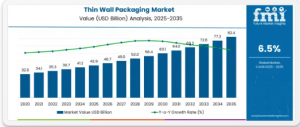Thin Wall Packaging - Top Europe Industry Trends in 2026
The global thin-wall packaging market is seeing rapid growth, driven by sustainability, lightweight design, and cost efficiency.
NEWARK, DE, UNITED STATES, November 21, 2025 /EINPresswire.com/ -- In a powerful demonstration of industrial momentum, the thin-wall packaging market is projected to reach approximately US$ 82.4 billion by 2035, expanding at a compound annual growth rate (CAGR) of roughly 6.5%. This data underscores the surging global demand for lightweight, cost-effective, and sustainable packaging solutions, particularly in fast-growth regions such as Asia-Pacific.
Key Market Insights at a Glance
The thin-wall packaging market is anchored by strong economic fundamentals and sustainability trends. Its value, estimated at around US$ 43.9 billion in 2025, reflects its widespread adoption across food, beverage, household, and personal-care sectors. Polypropylene (PP) dominates on the material front, accounting for over 40 percent of revenue, thanks to its balance of durability, recyclability, and cost. Injection molding remains the leading production method, contributing more than half of market share due to its efficiency, speed, and ability to produce thin-walled products at scale.
Consumers’ increasing preference for ready-to-eat meals, single-serve foods, and on-the-go dining is fueling demand for cups, tubs, trays, and lidded containers. Innovations such as in-mold labeling, barrier coatings (like EVOH and SiOx), and recycled-resin systems are accelerating adoption, enabling brands to marry branding appeal with performance and circular economy goals.
Regional Overview
The Asia-Pacific region is emerging as the fastest-growing and most dynamic market for thin-wall packaging. Rapid urbanization, the rise of e-commerce, and a growing convenience food culture are driving demand in countries like China and India. For instance, China’s market is forecast to grow at an annual rate nearing 8.8%, while India is expected to expand around 8.1%, reflecting strong consumption tailwinds, increasing investment in domestic production, and a growing focus on sustainable packaging solutions. North America and Europe continue to contribute significantly, spurred by regulatory pressure, brand innovation, and mature recycling infrastructures.
Competitive Landscape
Major global players are aggressively competing to capture value and drive sustainable innovation in the thin-wall packaging arena. Industry giants such as Amcor, Berry Global Group, Huhtamaki, Pactiv / Reynolds, and Silgan have strategically aligned their operations to offer downgauged, recyclable, and brandable containers. These companies are optimizing supply chains, collaborating with resin suppliers for food-grade recycled content, and investing in high-efficiency molding technologies to lower costs while preserving product quality. Their strategies reveal a clear shift: cost leadership must now coexist with environmental stewardship.
Segment Overview
When broken down by product type, cups lead the thin-wall packaging market, with a share of around 36 percent in 2025. These formats are popular in on-the-go food and beverage categories, and they lend themselves well to in-mold labeling for high-resolution branding. On the materials side, polypropylene holds the top spot, owing to its favorable properties and recyclability. Injection molding is the dominant process — accounting for more than half the market — enabled by advanced mold design, automation, and high-throughput production to achieve ultra-thin walls without compromising strength.
Applications vary widely: food (especially dairy, ready meals, and bakery), beverages, household products, personal care, and industrial goods all rely on thin-wall packaging because of its lightweight and efficient design.
Market Outlook: Powering the Next Decade
Looking ahead, the thin-wall packaging market is set to flourish under a confluence of powerful trends. First, sustainability remains a core driver: major brand owners are demanding packaging that reduces raw material usage, supports recycling, and aligns with circular economy goals. Second, technological advancements — notably in high-flow resins, stacked molds, and in-mold decoration — will reduce cycle times, improve throughput, and enable further wall-thickness reductions.
Third, regulatory momentum, especially in regions implementing extended producer responsibility (EPR), will accelerate adoption of recyclable mono-material systems. Finally, the continued growth of e-commerce and ready-meal consumption will sustain demand for lightweight, stackable containers with strong mechanical and barrier properties.
Key Players of the Sustainable Packaging Industry
Leading names in the sustainable thin-wall packaging market include Amcor, known for its pioneering use of recycled polymers; Berry Global, which offers a broad portfolio of rigid thin-wall products; Huhtamaki, which emphasizes fiber and polymer-based containers; Pactiv / Reynolds, a major supplier in North America; and Silgan, which targets high-volume food and household applications. These corporations are actively driving innovation in lightweighting, high-speed production, and post-consumer recycling.
Subscribe for Year-Round Insights → Stay ahead with quarterly and annual data updates: https://www.futuremarketinsights.com/checkout/24613
Recent Strategic Developments
Recently, industry players have made several notable moves. Amcor and converters have entered partnerships with resin suppliers to develop food-contact recycled polypropylene (rPP) and post-consumer PET streams. Manufacturers are investing in automation, such as high-cavitation and stack mold systems, to boost capacity and efficiency while minimizing cycle times. On the sustainability front, in-mold labeling, tethered lids, and barrier enhancements have become more common, enabling better brand communication and product protection without compromising recyclability. There is also a growing trend toward low-wall packaging designs that maintain performance while reducing raw material usage, thus supporting both cost-effectiveness and environmental goals.
Explore More Related Studies Published by FMI Research:
Europe Liners Market https://www.futuremarketinsights.com/reports/europe-liners-market
Tape Dispenser Industry Analysis in Japan https://www.futuremarketinsights.com/reports/tape-dispenser-industry-analysis-in-japan
Beverage Filter Paper Market https://www.futuremarketinsights.com/reports/beverage-filter-paper-market
About Future Market Insights (FMI)
Future Market Insights, Inc. (FMI) is an ESOMAR-certified, ISO 9001:2015 market research and consulting organization, trusted by Fortune 500 clients and global enterprises. With operations in the U.S., UK, India, and Dubai, FMI provides data-backed insights and strategic intelligence across 30+ industries and 1200 markets worldwide.
Why FMI: https://www.futuremarketinsights.com/why-fmi
Sudip Saha
Future Market Insights Inc.
+1 347-918-3531
rahul.singh@futuremarketinsights.com
Legal Disclaimer:
EIN Presswire provides this news content "as is" without warranty of any kind. We do not accept any responsibility or liability for the accuracy, content, images, videos, licenses, completeness, legality, or reliability of the information contained in this article. If you have any complaints or copyright issues related to this article, kindly contact the author above.

